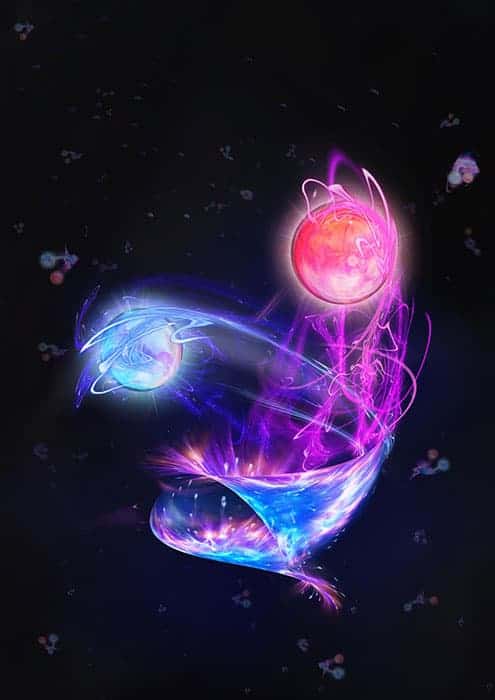
A quantum computer that can simulate interactions between fundamental particles has been unveiled by physicists in Austria. Four trapped ions were used to model the physics that describes the creation and annihilation of electron–positron pairs. While the result can be easily calculated using a conventional computer, problems that are beyond the reach of even the most powerful supercomputers could be solved by the computer if it could be scaled up to include about 30 ions.
The strange laws of quantum mechanics make it very hard for classical computers to model the behaviour of large numbers of microscopic particles. Because these objects can exist in superpositions and be entangled with one another, the amount of classical processing power needed to fully describe their interactions rises exponentially as the number of particles increases. It was this fact that prompted physicist Richard Feynman in the early 1980s to propose using quantum systems themselves – in the form of quantum computers – to model the behaviour of other quantum systems.
That vision has started to become reality in recent years, as scientists build quantum computers to simulate chemical reactions or devise new types of condensed-matter systems. These devices are nothing like the fabled all-purpose quantum computers capable of factorising large numbers, which would contain large numbers of quantum bits, or qubits. Instead, to date they contain just a handful of qubits, operating either as analogue devices – in which the interactions between qubits closely resemble those between the simulated particles – or digitally, where each interaction is represented by a series of discrete logical operations.
Gauge theories
Peter Zoller, Rainer Blatt and colleagues at the University of Innsbruck and the Institute for Quantum Optics and Quantum Information (IQOQI) have created a digital quantum computer and have used it to simulate the physics of a gauge theory. These theories describe how fundamental particles such as quarks or electrons interact with one another, and are at the heart of the Standard Model of particle physics. However, they impose severe constraints on modelling because each interaction they describe must obey a series of conservation laws not needed in other types of simulations. But over the last few years, theorists have begun to put forward algorithms that would allow quantum computers to model gauge theories.
The Austrian team has devised and implemented a quantum algorithm for efficiently modelling a simple type of gauge theory: one-dimensional quantum electrodynamics. The computer that the researchers use to run the algorithm uses four calcium ions as qubits. These are confined by electric fields and manipulated by a laser, so that each ion can exist in a superposition of two energy levels and can become entangled with the other ions.
Each ion represents a point in space, and its two energy levels correspond to the presence or absence of a particular subatomic particle – either an electron or a positron. Initially, the states of all four ions are set to show no particles, which means that the simulated system at that point is a pure vacuum. The ions’ quantum states are then changed by a series of red laser pulses fired at them. Those pulses can represent three effects: the creation or annihilation of electron–positron pairs in the vacuum; long-range electrical (Coulomb) interactions between the particles; or the energy associated with the particles’ masses. Once the sequence of laser pulses has ended, the final state of each qubit is read out using a second (blue) laser beam that causes the ions to emit light when they are in one energy state, but not when they are in the other.
Proof-of-principle
The team found that its quantum computer generated the correct final states within the margin of error imposed by laser noise and other limitations in the laboratory equipment. Although the calculation can be easily done using a normal desktop computer, team member Christine Muschik of IQOQI says the results provide a proof-of-principle demonstration that quantum computers can be used to simulate the interactions described by gauge theories.
The research is described in Nature. In an accompanying commentary, Erez Zohar of the Max Planck Institute of Quantum Optics in Garching, Germany, agrees that the research shows it is “realistic to use quantum-optics techniques to study particle physics and fundamental forces”. He believes that the quantum computer built by the Austrian group “serves as a beacon” to other physicists trying to build more complex devices, which, he says, might be able to simulate particle systems in more than one dimension or accommodate more complex gauge theories such as quantum chromodynamics.
Team member Esteban Martinez of the University of Innsbruck says that quantum simulators should outperform the best classical computers when they have about 30 qubits. He points out, in fact, that his group already has a simulator with that many ions, but says that the performance of this device is limited by the difficulty of addressing single ions and by instabilities in the lasers and magnetic fields. “We are working to improve all these things so that we can operate 30 ions in the same way that we currently operate four,” he says. As to when that might be possible, “10 years is a perfectly reasonable timescale,” he says.
The research is described in Nature.



